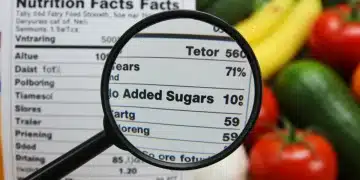2025 USDA Dietary Guidelines: What Updates Mean for Your Plate

The forthcoming 2025 USDA Dietary Guidelines are expected to introduce significant shifts in nutritional recommendations, impacting everything from early childhood nutrition to personalized dietary advice for chronic disease prevention.
As we approach 2025, the anticipation builds for the release of the 2025 USDA Dietary Guidelines, a pivotal document shaping nutritional advice across the United States. These guidelines are not just recommendations; they are the bedrock for federal food programs, health education, and ultimately, the dietary choices of millions of Americans. Understanding these recent updates is crucial for anyone looking to optimize their health and navigate the evolving landscape of nutritional science.
Understanding the Foundation of Dietary Guidelines
The Dietary Guidelines for Americans are a cornerstone of federal nutrition policy, jointly published by the U.S. Department of Agriculture (USDA) and the U.S. Department of Health and Human Services (HHS). Updated every five years, these guidelines provide evidence-based recommendations for healthy eating patterns to promote health, prevent chronic disease, and meet nutrient needs. They serve as a vital resource for health professionals, policymakers, and the public.
The process of developing these guidelines is rigorous and extensive, involving a comprehensive review of current scientific evidence by an independent advisory committee. This committee synthesizes vast amounts of research on diet and health, considering various factors like age, life stage, and cultural relevance. Their findings then inform the final guidelines, aiming to provide actionable advice that is both scientifically sound and practical for diverse populations.
The Scientific Advisory Committee’s Role
The Dietary Guidelines Advisory Committee (DGAC) plays an indispensable role in shaping the recommendations. Composed of leading nutrition and health experts, this committee meticulously reviews scientific literature to identify key areas for update and improvement. Their work is transparent, with public meetings and opportunities for public comment, ensuring a broad range of perspectives are considered.
- Reviewing the latest scientific research on nutrition and health.
- Identifying emerging trends and persistent health challenges.
- Formulating evidence-based recommendations for dietary patterns.
- Considering specific needs across different life stages, from infancy to older adulthood.
The committee’s recommendations are not taken lightly; they undergo extensive scrutiny and debate before being finalized. This ensures that the guidelines represent the most current and reliable scientific consensus available, aiming to offer the best possible advice for promoting public health.
In essence, the foundation of the Dietary Guidelines rests on a commitment to scientific rigor and public health. They are designed to be dynamic, adapting to new research and societal needs, ensuring that Americans receive the most up-to-date and effective guidance for healthy eating.
Key Anticipated Updates and Shifts in Focus
Early indications suggest the 2025 USDA Dietary Guidelines will feature several significant updates, building upon previous editions while incorporating the latest scientific insights. One notable shift is an increased emphasis on nutrition from birth through early childhood, recognizing the critical window for establishing healthy eating habits that impact lifelong health. This reflects a growing understanding of how early dietary exposures can influence long-term health outcomes and disease risk.
Another area of focus is expected to be more personalized dietary advice. While broad guidelines are essential, the committee is exploring ways to offer recommendations that better account for individual differences in metabolism, genetics, and lifestyle. This could mean a move towards more tailored guidance beyond a one-size-fits-all approach, acknowledging the diverse needs and preferences of the American population.
Emphasis on Early Childhood Nutrition
The period from birth to 24 months is crucial for growth and development. The upcoming guidelines are likely to provide more detailed recommendations for this age group, including guidance on breastfeeding, introduction of complementary foods, and avoiding added sugars. This early intervention is key to preventing childhood obesity and promoting healthy eating patterns from the very start.
- Specific recommendations for infant feeding practices.
- Guidance on introducing allergenic foods safely.
- Strategies to limit added sugars and sodium in young children’s diets.
- The importance of nutrient-dense foods for optimal development.
This heightened focus on early childhood nutrition underscores the long-term impact of dietary choices made during these formative years. By establishing healthy patterns early, the guidelines aim to set children on a path toward better health throughout their lives.
Furthermore, the 2025 guidelines are anticipated to reinforce the importance of sustainable eating patterns. While not directly dictating environmental policy, the recommendations often consider the broader implications of food choices on both personal health and planetary well-being. This might involve encouraging more plant-forward diets and reducing food waste, aligning with a holistic view of health.
The Evolving Science Behind Dietary Recommendations
Nutritional science is a dynamic field, constantly evolving with new research and discoveries. The 2025 USDA Dietary Guidelines are a direct reflection of this ongoing evolution, incorporating the most up-to-date evidence to refine and strengthen previous recommendations. This scientific progression ensures that the advice provided remains relevant and effective in addressing contemporary health challenges.
One area where science has significantly advanced is our understanding of the gut microbiome and its profound impact on health. While previous guidelines touched upon fiber and probiotics, the new iteration might delve deeper into specific dietary patterns that support a healthy gut, potentially influencing recommendations for fermented foods and diverse plant-based options. This represents a move beyond simply macronutrient and micronutrient considerations to a more complex understanding of how food interacts with our physiology.
Beyond Macronutrients: A Holistic View
The traditional focus on fats, carbohydrates, and proteins remains important, but modern nutritional science increasingly emphasizes the synergistic effects of whole foods and dietary patterns. The 2025 guidelines are expected to reflect this holistic view, moving beyond isolated nutrients to promote overall healthy eating patterns. This includes looking at the quality of carbohydrates and fats, rather than just their quantity, and emphasizing nutrient density.
- Increased emphasis on fiber and complex carbohydrates from whole grains.
- Distinction between healthy fats (e.g., from avocados, nuts, olive oil) and less healthy fats.
- The role of phytochemicals and antioxidants found in plant foods.
- Understanding the impact of food processing on nutritional value.
The scientific community’s understanding of chronic diseases like type 2 diabetes, heart disease, and certain cancers has also advanced, revealing stronger links to specific dietary components and patterns. The 2025 guidelines will likely integrate this knowledge to provide even more targeted advice for disease prevention and management, moving beyond general healthy eating to more specific actionable steps.
Ultimately, the evolving science behind these recommendations aims to empower Americans with the most effective tools to make informed dietary choices. By staying abreast of the latest research, the guidelines strive to offer practical and impactful advice for enhancing health and well-being.
Practical Implications for Your Daily Plate
The 2025 USDA Dietary Guidelines will inevitably translate into practical changes for what Americans put on their plates. While the core message of consuming a variety of fruits, vegetables, whole grains, and lean proteins will likely remain, the nuances of these recommendations could shift how we approach meal planning, grocery shopping, and even cooking. Understanding these practical implications is key to seamlessly integrating the new advice into your daily routine.
One anticipated change might involve more specific guidance on portion sizes and frequency for certain food groups, moving beyond general recommendations to provide clearer benchmarks. For instance, there could be revised recommendations for dairy or alternative protein sources, reflecting evolving dietary trends and scientific understanding of their health impacts. This specificity aims to make healthy eating more tangible and less open to interpretation for the average consumer.
Adapting Your Grocery List
Your weekly grocery run might see some adjustments based on the new guidelines. If there’s an increased emphasis on plant-based proteins, you might find yourself exploring more legumes, nuts, seeds, and plant-based meat alternatives. Similarly, if there’s refined guidance on dairy, you might consider different types of milk or fortified plant-based beverages.
- Prioritizing whole, unprocessed foods over highly processed options.
- Exploring new plant-based protein sources like lentils, chickpeas, and tofu.
- Stocking up on a wider variety of seasonal fruits and vegetables.
- Reading food labels more carefully for added sugars, sodium, and unhealthy fats.
These adjustments are not about deprivation but about making informed choices that align with the latest scientific understanding of optimal nutrition. The goal is to build a plate that is not only delicious but also maximally beneficial for your health, offering a wide array of nutrients.

Furthermore, the guidelines could influence how food is prepared at home. There might be a stronger push for cooking methods that preserve nutrients and minimize the addition of unhealthy fats or excessive sodium. This focus on home cooking empowers individuals to have greater control over the ingredients and preparation of their meals, fostering healthier eating habits.
Impact on Public Health and Policy
The 2025 USDA Dietary Guidelines extend far beyond individual dietary choices; they exert a profound influence on public health initiatives and national food policy. These recommendations serve as the scientific basis for federal nutrition programs, shaping everything from school lunch menus to food assistance programs. A shift in the guidelines can trigger a ripple effect across various sectors, impacting millions of Americans, especially those relying on these programs.
Consider the Women, Infants, and Children (WIC) program, which provides nutritious foods to low-income pregnant women, new mothers, and young children. Any updates in the dietary guidelines, particularly those related to early childhood nutrition, will directly inform the types of foods WIC participants are encouraged to purchase. This ensures that the most vulnerable populations receive food that aligns with the latest scientific understanding of healthy development.
Shaping Federal Food Programs
The guidelines are instrumental in defining what constitutes a healthy diet within federal programs. This includes:
- School Meals: Guiding the nutritional standards for lunches and breakfasts served in schools nationwide.
- SNAP (Supplemental Nutrition Assistance Program): Informing educational materials and potentially influencing purchasing incentives.
- Older Americans Act Nutrition Programs: Ensuring meals provided to seniors meet current nutritional recommendations.
- Military Rations: Contributing to the development of healthy eating options for service members.
Each of these programs relies on the Dietary Guidelines to ensure that the food provided or recommended supports the health and well-being of their beneficiaries. Therefore, even subtle changes in the guidelines can lead to significant adjustments in food procurement, preparation, and distribution across the country.
Moreover, the guidelines often serve as a benchmark for health organizations and food manufacturers. While not legally binding for the private sector, they influence product development, marketing strategies, and public health campaigns. A new emphasis on certain nutrients or food groups can lead to innovation in the food industry, with companies striving to align their products with the latest recommendations.
Ultimately, the impact of the 2025 USDA Dietary Guidelines on public health and policy underscores their critical role in shaping the nutritional landscape of the United States. They are a powerful tool for promoting healthier eating patterns on a national scale, fostering a healthier future for all.
Addressing Common Misconceptions and Challenges
Despite their scientific rigor and public health importance, the USDA Dietary Guidelines often face scrutiny and can be subject to various misconceptions. One common challenge is the perception that healthy eating is overly restrictive or expensive. The 2025 guidelines will likely continue to emphasize flexibility and cultural relevance, aiming to dispel the notion that healthy eating is a one-size-fits-all, rigid approach. They strive to provide a framework that can be adapted to diverse dietary preferences and budgets.
Another misconception revolves around the idea that dietary advice is constantly changing, leading to public confusion and distrust. While nutritional science does evolve, the core principles of healthy eating—consuming plenty of fruits, vegetables, whole grains, and lean proteins—have remained remarkably consistent over decades. Updates typically involve refinements and deeper insights, rather than complete reversals of previous advice. The 2025 guidelines will aim for clarity and consistency, reinforcing enduring principles while integrating new knowledge.
Navigating Dietary Advice in a Complex World
In an age of abundant information, discerning credible dietary advice from misinformation can be challenging. The guidelines serve as an authoritative, evidence-based source, helping individuals navigate the often-conflicting messages found online or in popular media. They provide a reliable standard against which other dietary claims can be evaluated.
- Distinguishing between evidence-based recommendations and fad diets.
- Understanding that flexibility and moderation are key to sustainable healthy eating.
- Recognizing that individual needs may vary, but core principles apply broadly.
- Seeking advice from qualified health professionals for personalized guidance.
The guidelines also face the challenge of effectively communicating complex scientific information to the general public in an accessible and actionable way. This involves using clear language, visual aids, and practical examples to ensure that the recommendations are easily understood and implemented by people from all walks of life.

Ultimately, addressing these misconceptions and challenges is vital for the effective uptake and impact of the 2025 USDA Dietary Guidelines. By providing clear, consistent, and adaptable advice, they aim to empower Americans to make informed choices that contribute to better health and well-being, fostering a more food-literate society.
Preparing for the Future of American Nutrition
As the release of the 2025 USDA Dietary Guidelines draws nearer, it’s an opportune moment for individuals, families, and communities to begin preparing for the future of American nutrition. These guidelines are more than just a document; they represent a collective effort to improve public health through informed dietary choices. Proactive engagement with the anticipated updates can lead to smoother transitions and more effective adoption of healthier eating patterns.
One key aspect of preparation involves staying informed about the scientific discussions and preliminary recommendations as they emerge. Following reputable sources, such as the USDA and HHS websites, and engaging with health professionals can provide valuable insights before the official release. This foresight allows for gradual adjustments to dietary habits, rather than abrupt changes, making the transition more sustainable.
Empowering Individual Choices
The guidelines are designed to empower individuals to make healthier choices, but personal initiative is crucial. This includes:
- Educating yourself on basic nutrition principles.
- Experimenting with new healthy recipes and ingredients.
- Planning meals and snacks in advance to avoid impulsive, less healthy options.
- Creating a supportive home environment that encourages healthy eating for all family members.
By taking ownership of your dietary choices, you can proactively align your eating habits with the forthcoming recommendations. This approach fosters a sense of agency and makes the process of adopting new guidelines more manageable and enjoyable.
Furthermore, communities and institutions can play a significant role in preparing for the future of American nutrition. Schools, workplaces, and local governments can review their food policies and offerings to ensure they are aligned with the latest evidence. Promoting access to affordable, nutritious foods and supporting initiatives that encourage healthy eating are critical steps in creating a healthier food environment for everyone.
The 2025 USDA Dietary Guidelines will undoubtedly shape the conversation around food and health for the next half-decade. By understanding their foundation, anticipating key updates, and actively preparing for their implementation, we can collectively move towards a healthier, more vibrant future for American nutrition.
| Key Update Area | Brief Description |
|---|---|
| Early Childhood Nutrition | Increased focus on birth to 24 months, with detailed guidance on infant feeding and avoiding added sugars. |
| Personalized Dietary Advice | Moving towards tailored recommendations that consider individual needs and variations. |
| Holistic View of Food | Emphasis on whole foods and dietary patterns over isolated nutrients, including gut microbiome health. |
| Sustainable Eating Patterns | Encouraging plant-forward diets and reduced food waste for both health and environmental benefits. |
Frequently Asked Questions About the 2025 USDA Dietary Guidelines
The 2025 USDA Dietary Guidelines are the upcoming federal recommendations for healthy eating patterns for Americans. They are updated every five years by the USDA and HHS, based on the latest scientific evidence, to promote health and prevent chronic diseases across all life stages.
An independent Dietary Guidelines Advisory Committee, composed of leading nutrition and health experts, reviews scientific evidence. Their findings inform the final guidelines, which are then officially published by the U.S. Department of Agriculture (USDA) and the U.S. Department of Health and Human Services (HHS).
While core principles remain, anticipated updates may include more specific guidance on early childhood nutrition, personalized dietary advice, and an increased emphasis on whole foods and sustainable eating. This might involve adjusting your grocery list or meal preparation methods.
Yes, it is anticipated that the 2025 guidelines will likely reinforce or expand upon recommendations for plant-forward eating patterns. This aligns with public health goals for both individual health benefits and broader environmental sustainability, encouraging diverse sources of protein and nutrients.
The 2025 USDA Dietary Guidelines serve as the scientific foundation for many federal nutrition programs, including school lunches, WIC, and SNAP. Updates will directly influence the nutritional standards and food recommendations within these programs, ensuring alignment with the latest scientific understanding of healthy eating.
Conclusion
The upcoming 2025 USDA Dietary Guidelines mark a pivotal moment in shaping the nutritional future of the United States, setting the tone for how families, schools, and policymakers approach food and health.
With a stronger emphasis on early-life nutrition, cultural inclusivity, and science-backed dietary patterns, these guidelines aim to bridge the gap between public health goals and real-world eating habits.
Adapting to these recommendations will require not just awareness but a willingness to embrace gradual, sustainable change.
As conversations around food policy evolve, resources like nutrition advocacy platforms such as https://www.cspi.org/advocacy/nutrition/dietary-guidelines-americans can help individuals and organizations understand the broader impact of these guidelines beyond personal diet.
They serve as essential tools for interpreting policy shifts and transforming them into meaningful actions within communities, healthcare programs, and educational systems.
Ultimately, the effectiveness of the 2025 USDA Dietary Guidelines will depend on how well they are communicated, implemented, and lived out in daily routines.
By staying informed, participating in nutrition-focused dialogues, and making incremental but consistent changes, individuals and institutions alike can contribute to a healthier, more resilient food landscape that supports long-term public well-being.





